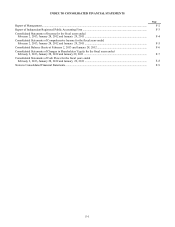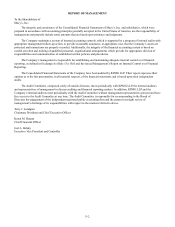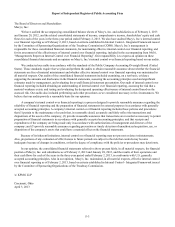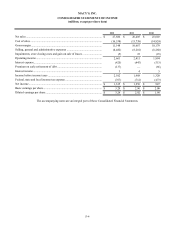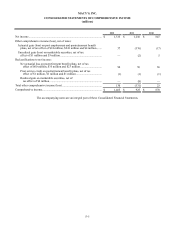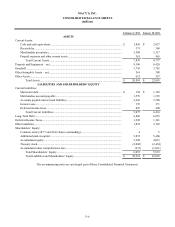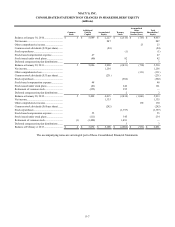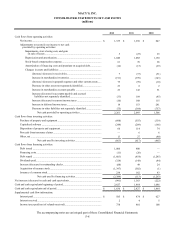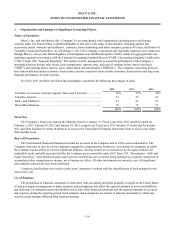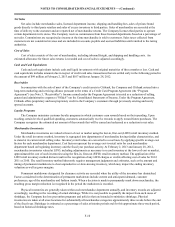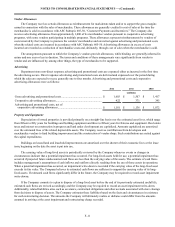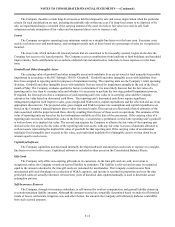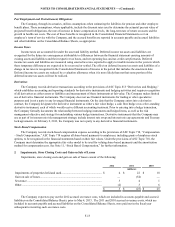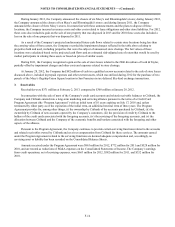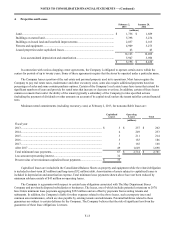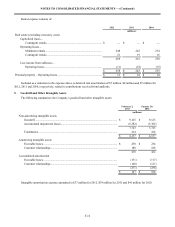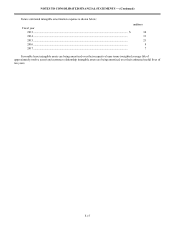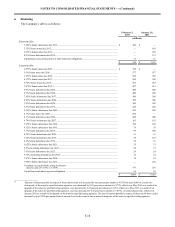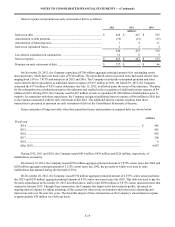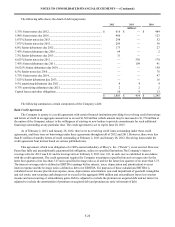Macy's 2012 Annual Report Download - page 57
Download and view the complete annual report
Please find page 57 of the 2012 Macy's annual report below. You can navigate through the pages in the report by either clicking on the pages listed below, or by using the keyword search tool below to find specific information within the annual report.
NOTES TO CONSOLIDATED FINANCIAL STATEMENTS — (Continued)
F-10
Net Sales
Net sales include merchandise sales, licensed department income, shipping and handling fees, sales of private brand
goods directly to third party retailers and sales of excess inventory to third parties. Sales of merchandise are recorded at the
time of delivery to the customer and are reported net of merchandise returns. The Company licenses third parties to operate
certain departments in its stores. The Company receives commissions from these licensed departments based on a percentage of
net sales. Commissions are recognized as income at the time merchandise is sold to customers. Sales taxes collected from
customers are not considered revenue and are included in accounts payable and accrued liabilities until remitted to the taxing
authorities.
Cost of Sales
Cost of sales consists of the cost of merchandise, including inbound freight, and shipping and handling costs. An
estimated allowance for future sales returns is recorded and cost of sales is adjusted accordingly.
Cash and Cash Equivalents
Cash and cash equivalents include cash and liquid investments with original maturities of three months or less. Cash and
cash equivalents includes amounts due in respect of credit card sales transactions that are settled early in the following period in
the amount of $99 million at February 2, 2013 and $107 million at January 28, 2012.
Receivables
In connection with the sale of most of the Company’s credit assets to Citibank, the Company and Citibank entered into a
long-term marketing and servicing alliance pursuant to the terms of a Credit Card Program Agreement (the “Program
Agreement”) (see Note 3, “Receivables”). Income earned under the Program Agreement is treated as a reduction of selling,
general and administrative expenses ("SG&A") on the Consolidated Statements of Income. Under the Program Agreement,
Citibank offers proprietary and non-proprietary credit to the Company’s customers through previously existing and newly
opened accounts.
Loyalty Programs
The Company maintains customer loyalty programs in which customers earn rewards based on their spending. Upon
reaching certain levels of qualified spending, customers automatically receive rewards to apply toward future purchases. The
Company recognizes the estimated net amount of the rewards that will be earned and redeemed as a reduction to net sales.
Merchandise Inventories
Merchandise inventories are valued at lower of cost or market using the last-in, first-out (LIFO) retail inventory method.
Under the retail inventory method, inventory is segregated into departments of merchandise having similar characteristics, and
is stated at its current retail selling value. Inventory retail values are converted to a cost basis by applying specific average cost
factors for each merchandise department. Cost factors represent the average cost-to-retail ratio for each merchandise
department based on beginning inventory and the fiscal year purchase activity. At February 2, 2013 and January 28, 2012,
merchandise inventories valued at LIFO, including adjustments as necessary to record inventory at the lower of cost or market,
approximated the cost of such inventories using the first-in, first-out (FIFO) retail inventory method. The application of the
LIFO retail inventory method did not result in the recognition of any LIFO charges or credits affecting cost of sales for 2012,
2011 or 2010. The retail inventory method inherently requires management judgments and estimates, such as the amount and
timing of permanent markdowns to clear unproductive or slow-moving inventory, which may impact the ending inventory
valuation as well as gross margins.
Permanent markdowns designated for clearance activity are recorded when the utility of the inventory has diminished.
Factors considered in the determination of permanent markdowns include current and anticipated demand, customer
preferences, age of the merchandise and fashion trends. When a decision is made to permanently mark down merchandise, the
resulting gross margin reduction is recognized in the period the markdown is recorded.
Physical inventories are generally taken within each merchandise department annually, and inventory records are adjusted
accordingly, resulting in the recording of actual shrinkage. While it is not possible to quantify the impact from each cause of
shrinkage, the Company has loss prevention programs and policies that are intended to minimize shrinkage. Physical
inventories are taken at all store locations for substantially all merchandise categories approximately three weeks before the end
of the fiscal year. Shrinkage is estimated as a percentage of sales at interim periods and for this approximate three-week period,
based on historical shrinkage rates.



